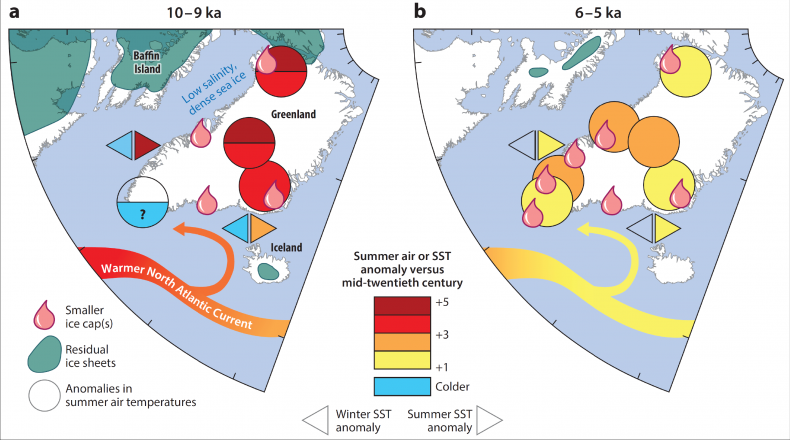The author(s) will give a talk
The Holocene Thermal Maximum across Greenland: Reconciling differences in the timing and magnitude of peak warmth
1 Northwestern University
2 Université du Québec à Montréal
3 Dartmouth College
In the early to middle Holocene, higher boreal summer insolation drove thousands of years of elevated temperatures across much of the Arctic including Greenland. In Greenland, the timing, magnitude and seasonality of Holocene warmth have remained ambiguous despite decades of research. For example, a subset of temperature reconstructions (mostly based upon pollen, ice cores from the Greenland Ice Sheet, and nearshore marine sediments) suggest modest peak warmth in the middle Holocene – lagging long after peak summer insolation forcing, and supporting the hypothesis that decaying ice sheets suppressed early Holocene temperatures across a large part of the North Atlantic region. In contrast, the other subset of temperature reconstructions (mostly derived from marginal ice caps, midges in lakes, and offshore marine records) record dramatic peak warmth during the early Holocene. The latter records support the primacy of insolation forcing over Greenland, and may also imply that strong feedbacks amplified warming in the region. These alternate temperature histories have very different implications for understanding how ice sheet decay modulates climate change in this sensitive region, and how the ice sheet itself responds to warming.
To more confidently characterize Greenland’s Holocene temperature history, we compiled published long-term (>7000-year long) quantitative air and sea surface temperature reconstructions from ice, lake sediment and marine sediment cores. We also compiled qualitative evidence for warmer-than-present local conditions from extralimital terrestrial fauna and the past disappearance or reduced size of numerous modern-day mountain glaciers and ice caps. Some key findings include:
• There is compelling evidence that summer air temperatures rose above those of the mid-20th Century in the early Holocene around much of Greenland, indeed by 10 ka in many regions including over the central ice sheet. Maximum summer temperature anomalies in the east, northwest and over the central ice sheet occurred in the early Holocene and were as large as 3 to 5 °C above mid-20th Century summer temperatures.
• The far south and southwest (adjacent to the Labrador Sea) may be exceptions where early Holocene warming was muted and peak summer air temperatures occurred in the middle Holocene. However, more records are needed to confirm this pattern.
• The notion of middle Holocene peak warmth across much of Greenland arose from a combination of (1) proxy-specific issues, namely proxy seasonality (winter trends may oppose or mute summer signals in annual proxies like stable isotopes of ice), changes in ice sheet surface elevation (with higher elevations of core sites in the early Holocene masking regional summer warmth in ice core proxies), and lagged vegetation migration and/or no-analog vegetation in the early Holocene, and (2) the effects of ice sheet meltwater on sea-surface conditions. Along Greenland’s coasts in the early Holocene, freshwater discharge from the rapidly shrinking Greenland Ice Sheet led to strong stratification of near-shore surface waters and thus increased winter sea ice and cold winters – while offshore sites strongly influenced by the North Atlantic Current experienced very warm sea surface conditions.
• Overall, our compilation points to higher early Holocene summer air temperatures over the ice sheet than are often presumed, including in studies designed to test ice sheet models. Our results confirm the primacy of summer insolation in driving summer temperature trends around Greenland. They also reinforce that the early Holocene was a period of competing strong and complex influences on Greenland climate, leading to significant spatial and seasonal heterogeneity of temperature trends. In comparison, temperature reconstructions in the middle and late Holocene are characterized by more widespread agreement between proxies and settings and the vast majority of middle to late Holocene temperature-sensitive proxy records mirror insolation forcing on a multi-millennial timescale.
Acknowledgements
We thank the many colleagues whose research contributed to this compilation, and the people of Kalaallit Nunaat for welcoming scientists to their homeland. This review was supported by US NSF CAREER grant OPP-1454734, the Natural Sciences and Engineering Research Council of Canada, and the Fonds de Recherche du Québec-Nature et Technologies. An advance proof of the corresponding article is available from Annual Review of Earth and Planetary Sciences, doi:10.1146/annurev-earth-081420-063858.
On this occasion of the 50th Arctic Workshop, we also thank John T. Andrews for inspiring and supporting decades of investigations into the paleoclimate history of northeastern North America.

Fig 1.
Summary of major climatic differences around Greenland from (a) 10-9 ka versus modern and (b) 6-5 ka versus modern, including: Anomalies in summer air temperature (circles; estimates for Summit reflect elevation correction of reconstructions from Buizert et al 2018), winter SST (left triangles) and summer SST (right triangles) compared to the mid-20th century AD; large differences in sea-surface salinity and sea ice (italicized text); regions with ice caps and mountain glaciers smaller than today (droplets); and major residual Pleistocene ice sheets that are now absent (gray shading). From 10-9 ka the Greenland Ice Sheet was thicker at Summit than today (Vinther et al 2009) but similar in area; from 6-5 ka the ice sheet was smaller than today, with its minimum size poorly constrained (Larsen et al 2015, Young & Briner 2015). Half circles reflect larger uncertainties or ranges between air temperature proxies. Gray triangles indicate SSTs similar to the mid-20th century. Note enhanced SST seasonality in the early Holocene, with lower winter and higher summer SSTs.
This figure appears in the corresponding article in Annual Review of Earth and Planetary Sciences, doi:10.1146/annurev-earth-081420-063858.